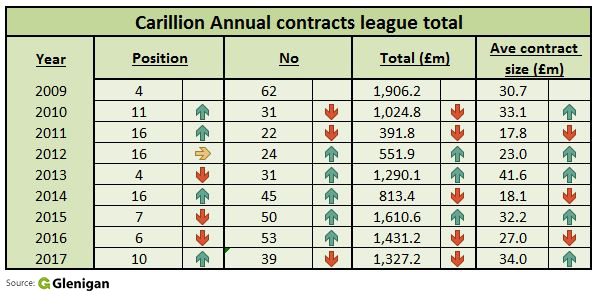Carillion has disappeared from the annual contracts leagues after one of Britain’s biggest contractors filed for compulsory liquidation on 15 January 2018
What went wrong at Carillion is still being worked out, but the company has been consistently ranked amongst the industry’s top 20 contractors by orders according to Glenigan’s research.
The highest end-of-year ranking in the past decade was fourth, which was achieved in 2009, when orders totalled £1.9 billion, and again in 2013 with a smaller order book (see table).

Glenigan’s research, which excludes term maintenance and framework agreements, shows a clear reduction in contracting workload in 2011 and 2012.
This came as the group moved further into support services and facilities management work and acquired heating and renewable energy group Eaga for £306 million in 2011.
This acquisition did not work out as tariffs on solar energy were reduced, while other support services work did not produce the returns that the management expected.
As a result, Carillion sought more contracting work, which typically aids cash balances albeit only in the short term as this money needs to be paid out to the supply chain.
This return to contracting work pushed up the orders total and also raised the risk profile as the company took on larger projects, which typically carry more risk as problems with delays can be costly.
In 2013, Glenigan’s research shows that Carillion’s annual order book ballooned by 134% and the size of the average construction contract won by the company leapt by 81% to £41.6 million.
This measure subsided in 2015 but leapt again in 2016 as Carillion took on larger projects, such as the £745 million Aberdeen Western Bypass scheme.
Cost over-runs on this deal, which was won in joint venture with Balfour Beatty and Galliford Try, was among the troublesome contracts that took Carillion into liquidation.
In 2017, the size of the average contract won by Carillion had reached £34.0 million, which was the second highest in the last nine years. This rise was partly produced by taking on work on HS2 in the Midlands, which was where the company’s largest regional exposure could be found.
At the end of 2017, Carillion was ranked amongst the top 10 contractors by orders in four of the 11 British economic regions. The biggest regional exposure was in the West Midlands, where the company won £463.3 million-worth of work last year and was ranked fifth.
In the East Midlands, Carillion was ranked third with an order book totalling £240.3 million. In the North West, the group’s order book of £195.1 million left Carillion ranked sixth and orders totaling £95.6 million in Wales merited eighth place at the end of 2017.
As one of the industry’s biggest players disappears from league tables, an opportunity arises for small-to-medium-sized contractors to make a play for the work that will inevitably come up for grabs after Carillion’s liquidation.


